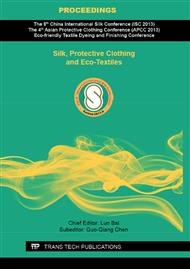p.277
p.281
p.286
p.290
p.294
p.301
p.306
p.311
p.317
Preparation and Mechanical Properties of Polystyrene Fibrous Membranes via Electrospinning
Abstract:
Polystyrene (PS) ultrafine fibrous membranes were prepared by electrospinning. The effects of PS molecular weightand auxiliary electrode on jet splitting behavior, fiber morphology and mechanical properties of the fiber nonwovens were investigated. The jet splitting behavior was examined by high-speed camera, the fiber morphology was observed with scanning electron microscopy, the mechanical properties of the membranes were measured with universal tensile machine. The results showed that, the stable jet length, the fiber diameters and the density of the mats are all increased in the presence of auxiliary electrode. The increase of polymer molecular weight postpones jet splitting, and enlarges fiber diameters and elevates the tensile strength of the membranes. Heat treatments of the membranes both at atmospheric pressure and high pressure significantly promote conglutination among filaments and heighten the tensile strength. The presence of solvent molecules in the fiber mats impairs mechanical properties to some extent when the two heat treatment modes are contrasted.
Info:
Periodical:
Pages:
294-300
Citation:
Online since:
September 2013
Authors:
Keywords:
Price:
Сopyright:
© 2013 Trans Tech Publications Ltd. All Rights Reserved
Share:
Citation:


